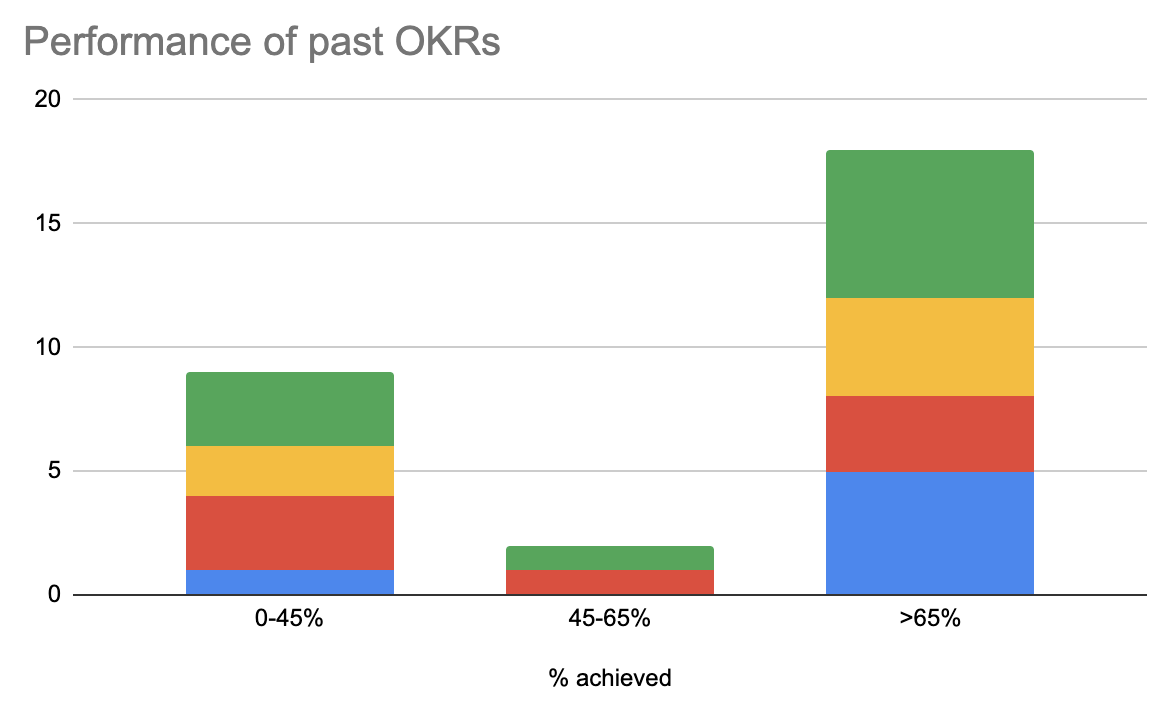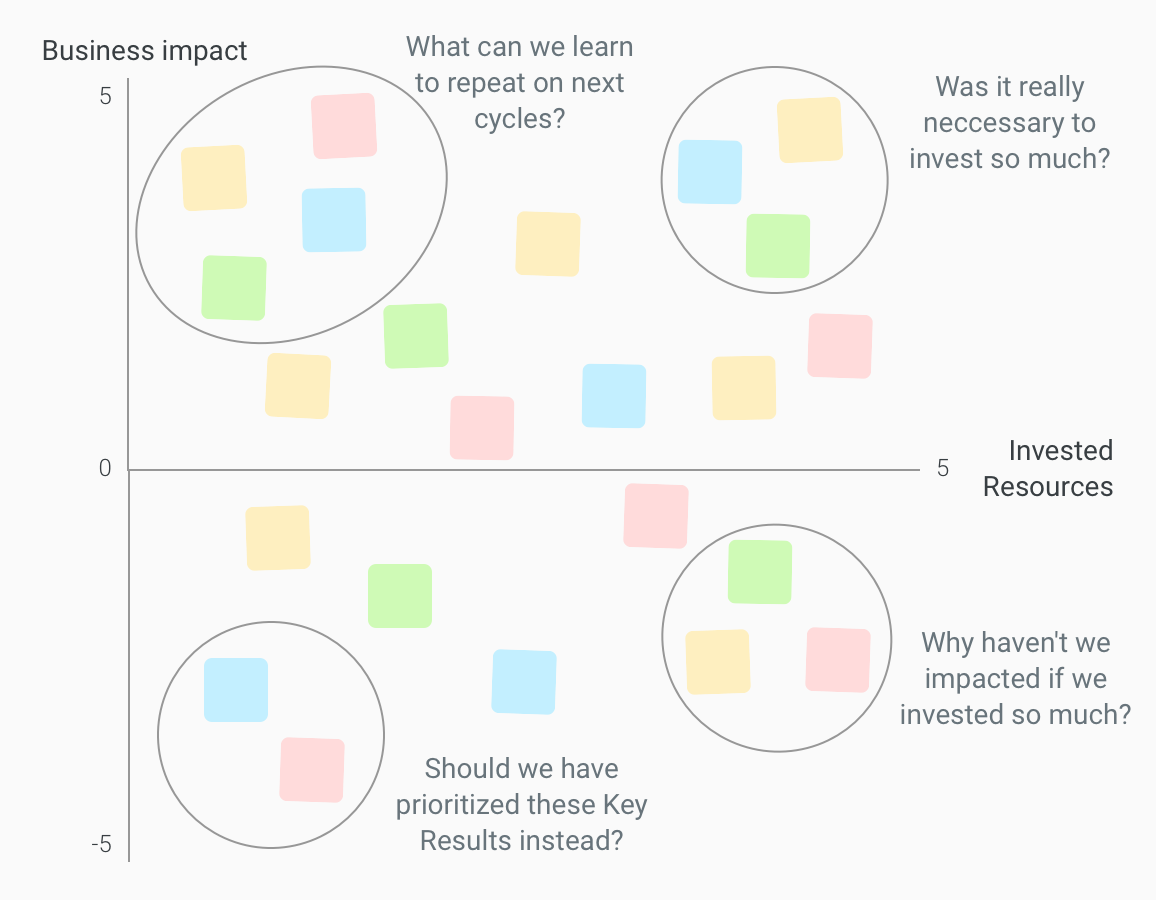Two exercises to review your past OKRs to achieve high performing teams
This article was originally posted in the Ontruck Product blog.

You are already working with OKRs instead of promising features in a roadmap, but how do you make sure you cause the expected impact? Achieving the OKRs is just one half of the answer, making sure those OKRs actually move the needle in the company is the other half.
At Ontruck, we wanted to learn how well we did in the last two cycles of 2019 before setting up the new OKRs of Q1 2020. So, we organized several exercises to obtain those learnings.
Achieve the OKRs
A key first step is that your teams achieve around 70% of OKRs (reminder — you should set ambitious targets so achieving 70% of them is great). This is a way of proving if your teams are high performing and predictable. They achieve the objectives they set.

The first exercise is to ask your Product Managers and Engineering Leads to rate the OKRs once the cycle has finished. They should rate 1-to-5 based on their happiness about the results, and explain why.
Then, compare those ratings with the actual results of the OKRs. Dig deeper on:
- How different are the ratings from the actual results? Why?
- Why have they achieved over 70% on some OKRs? Is it because the target wasn’t ambitious enough, or because the solutions were really successful?
- Why haven’t they achieved other OKRs? Is it because they had too many, or the target was too ambitious, or they had blockers, or they didn’t execute well or solutions weren’t successful?
I recommend that teams fill out a Spreadsheet async, and then, have a session together to discuss and challenge the conclusions.
Remember that this first exercise is about understanding why they have or haven’t achieved what they proposed. It isn’t yet about analyzing the impact on the company.
OKRs move the needle in the business
The second step is to analyze the impact of the OKRs on the business. We may have achieved 100% on a Key Result, but the real success comes if it really improved a part of the business. So, remind yourself and the team your end goal is to improve the business, delivering the OKRs isn’t the final objective.
Setting up great OKRs is really complicated. Choosing the targets is complicated, but selecting the number to change is even harder. On which part of the funnel should you focus this quarter? Which number can you really move without blockers from other teams? Is the Key Result meaningful in the long term, or is it a proxy for a solution you are thinking of implementing on the next cycle?
The second exercise is to ask your Product Managers and Engineering Leads to rate the business impact and the invested resources of each Key Result. Before doing that, it would be great if PMs or you as Product Lead, get first the feedback from stakeholders to complement your own perception. It can be healthy also to invite key stakeholders to the session.
In a session together, ask them to place a post-it per Key Result on a graph with two dimensions. Each team should use a different color. You can potentially do this async also.
- Business Impact (from -5 to 5). A Key Result would be -5 if the execution or lack of execution was damaging for the company. Imagine you had a KR about performance, you didn’t achieve it, and you lost many orders because of that. It would be -5 also if the business couldn’t advance because the team didn’t achieve it. A Key Result would be 5 if it changed the company. Therefore, the majority of achieved Key Results should be between 0 to 3.
- Resources Invested (from 0 to 5). Take into account engineers, designers, data analysts, PMs, etc. A Key Result would be 0 if you haven’t invested anything. It would be 5 if many people worked on it during the cycle.

Once they have placed them, each team should choose three good and three bad examples to share and discuss. You should ask questions and challenge their conclusions. You should collect the learnings as a group. It’s not the moment to give hard feedback to a PM or EL. That should be done in private.
Some questions to analyze on this session:
- Have they prioritized the key Key Results or have they done only the low hanging fruit?
- Have they chosen the right part of the funnel to tackle?
- Have they worked aligned with the business?
- Have the product changes been successfully implemented in the processes of the different business teams of each country?
During both exercises, you will talk about how you can set better OKRs. My recommendation is that you take notes of the good and bad examples, and at the end of the second session, you invest 15min to do a recap of best practices. You can use the SMART goals framework to structure them. I will share a follow-up article on the next days with our learnings and best practices.
You may be wondering why we invite the Engineering Leads. Aren’t those sessions just for Product Managers? This is very related to the product development philosophy at Ontruck, where we call the developers Product Engineers, we expect analysis and solutions to come from anyone in the team, and the Engineering Lead is a key partner of the Product Manager. We want to leverage Engineering as much as possible.
The latest point I want to mention is that OKRs must follow your product vision, not just short-term company goals. There must be a story behind each Key Result. Why are you doing that step this quarter? What’s the north star?
The best Product Managers combine nicely the product and tech vision, the alignment with company goals and short-medium-term business objectives, and the OKRs of each quarter.